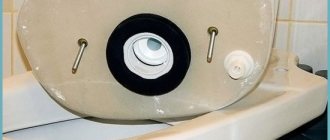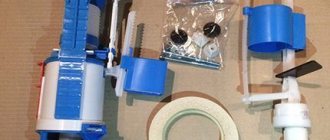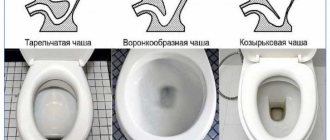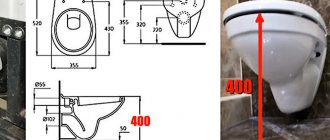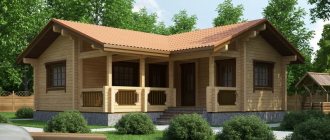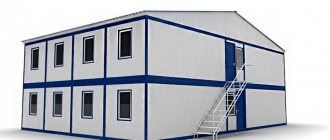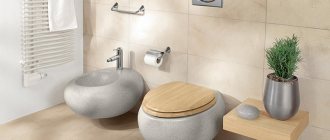The parameters of bathrooms in apartments do not always have sufficient area for the standard placement of all key plumbing fixtures. The solution to this problem lies in clearly thinking through the location and choosing compact models of functional key items. One of which is a corner toilet with a cistern - an advantageous design for the original design of an adjacent bathroom.
In this article we will analyze in detail the advantages and disadvantages of such toilet models, possible installation schemes and focus on the features of their connection to communication networks. We will supplement the presented material with visual photos and useful tips on choosing a suitable toilet for installation in the corner of the bathroom.
Pros and cons of corner plumbing fixtures
The design of corner toilets is practically no different from the standard version. The difference lies in the shape of the tank; it is made in the form of a triangle, although this design does not have any effect on the volume of the container.
A toilet in the corner of a bathroom or toilet allows you to increase the free space in the room and makes its interior extraordinary. By filling the corners with plumbing fixtures, you can visually increase the internal space by acquiring rounded shapes.
Corner toilets are available in two versions:
- Monoblock
. The model is a structure of two connected parts, a floor-standing toilet and a flush cistern. - Compact
. This model uses a wall-hung toilet, and the tank is installed in a corner niche. In some cases, the water supply and drainage system is disguised behind a false wall. When purchasing such structures, you must remember that their weight can be up to 500 kg.
If the bathroom in the apartment is separate, then additional devices can be placed in the toilet room, for example, a bidet and a corner wall-hung toilet. Suspended structure
The main advantage of corner toilets is the strength and reliability of the cistern. In such cases, it is made of solid material, which completely eliminates the formation of leaks.
Most of the corner-type models are equipped with an emergency system, thanks to which, in the event of a breakdown, excess network water is directed into a special overflow channel. Installing such plumbing equipment allows the owner not to think about the problem of flooding of neighbors below.
Among the disadvantages of such models is the rather large weight, which should be taken into account when installing a corner toilet. To install wall-hung toilets, you must choose a solid wall. In the case of plasterboard wall structures, it is necessary to place a strong embedded material under the sheathing. The toilet is attached to it with bolts, the length of which should be sufficient to pass through the wooden elements and grip the main wall.
How to save money?
Owners of tiny bathrooms can also save on purchasing a toilet. Since not everyone is willing to pay a lot of money for corner models, there is an option to simply purchase a compact toilet that will fit successfully into the corner of the room.
Compact designs have a smaller tank width so it can easily fit into any corner. Plumbing of this type looks harmonious. And the cost of such products can be an order of magnitude lower than corner models. For example, a budget option will cost from 3,000 rubles.
Modern plumbing is represented by a variety of models; manufacturers have long moved away from classical standards. The main task of the equipment is to solve the problems of interior design in the bathroom. And corner toilets do an excellent job of organizing limited space.
0 0 votes
Article rating
Types of corner toilets with a cistern
Recently, more and more often, consumers are choosing non-standard plumbing fixtures, which are characterized by original appearance, comfort and functionality. This category of products includes corner toilets, which not only have a different cistern shape from standard models, but also some features of the installation process.
When choosing a corner toilet, you need to consider various factors. In particular, we are talking about the material of manufacture, the shape of the bowl, the type of sewer outlet and the method of fastening the plumbing. It is worth noting that such products are presented in a less wide range compared to the classic version.
Types of designs
Corner sanitary fixtures are produced in two types:
- Hanging.
- Floor-standing.
Recently, hanging models with corner installation have become increasingly popular, as we see in the photo. Such designs are made from earthenware, porcelain, plastic, artificial or natural stone and even glass. Also, models can be of different colors, with ornaments and patterns. Moreover, corner toilets can be supplemented with all sorts of functions:
- Microlift system for smooth lowering of the lid.
- Hygienic shower.
- Bidet lid.
Combining several functions, corner structures allow you to carry out all the necessary hygiene procedures using one sanitary item.
Advantages of hanging models:
- Requires a minimum of free space.
- Thanks to the panel that covers the drain mechanism, the noise from draining water is muffled.
- Easy to use and keep clean.
- Reliable and durable.
- They do not interfere with the installation of heated floors and tiles.
Floor designs will appeal to those who want to decorate their toilet room in a stylish and original way. Such toilet models, as in the photo, are produced in different colors and from different materials. Taking into account financial capabilities and personal preferences, you can purchase a corner toilet made of plastic, sanitary ware, natural or artificial stone, glass or porcelain.
Our range:
Floor-standing toilet Jacob Delafon 66 x 36.5 cm E0525-00 RUB 16,998
Floor-standing compact toilet OWL Vind Cirkel-G OWLT190303 with DP microlift seat RUB 14,350
Floor-standing compact toilet OWL Vind Cirkel-GL OWLT190301 with DP microlift seat RUB 14,150
Floor-standing toilet with cistern * dual-mode fittings 3/6 liters Boheme 941 white 37,652 RUR
43300 rub.
Material of manufacture
In the production of corner toilets, standard materials are used, such as plastic, porcelain, earthenware.
The material for the manufacture of most plastic toilets is acrylic, reinforced with fiberglass and special resin. The products are lightweight and simple, have a high degree of strength and a non-porous structure. This is the main advantage of plastic toilets. However, such plumbing does not tolerate temperature changes and strong mechanical stress.
Porcelain toilets are characterized by higher strength, which significantly increases the service life of such products. Corner toilets with a complete cistern are made from white clay with the addition of quartz and feldspar, which makes the structure of the material less porous. The final coating – a special glaze – ensures the surface of the toilet is perfectly smooth, making maintenance of the equipment quick and easy. The disadvantages include a higher price level.
Earthenware toilets are among the plumbing fixtures with an affordable price. Thanks to additional firing of earthenware products and glazing at the final stage of production, the porosity of the material is reduced, the service life of finished products is increased, and maintenance of plumbing fixtures becomes more convenient and faster. The average service life of earthenware toilets is about 15 years.
Bronze and steel toilets, as well as plumbing fixtures made from natural materials, are much less common, since the cost of such products is very high. This is the main reason for low consumer demand, so the model range is very rarely replenished with new products.
In public places you can often find corner toilets made of galvanized steel. They are a structure in which the toilet is combined with a sink. Therefore, such equipment can be classified as anti-vandal goods.
Most standard models are made of porcelain. In their production, high-quality materials are used, which are characterized by a low degree of moisture absorption. Such models retain their functional and visual qualities throughout their entire service life.
What should you consider when making your choice?
To choose a reliable and not too expensive corner toilet with a cistern, you need to know which parameters you should pay special attention to. With the right knowledge, you will buy something that will not cause you later feelings of disappointment and regret.
This is roughly what the layout of a corner model of a toilet looks like if you place it on the bisector line of the corner of the bathroom
- Toilet location. The future location of the toilet must be determined in advance. When choosing a model, you need to have a good idea of how it will be located. The toilet itself can be placed almost parallel to the wall, but the cistern will have to be moved slightly to the side. You can place the toilet on the bisector of the corner of the bathroom. Accordingly, the tank is placed at an angle of 90 or 45 degrees. If the riser is located along the wall, it is quite difficult to install a corner structure, but it is possible if you use additional wiring in the form of corrugations or hoses.
- Connection. To successfully install a toilet, you need to make sure that there are opportunities to connect it to communications. Cold water supply to the corner model can be done in one of two ways: from the side and from the bottom. To avoid the need for extra connections, you need to choose a toilet that matches the communications already in the bathroom.
- Design. If the bathroom is made in a certain style or has a certain color scheme, you need to choose a model taking into account all the requirements for its appearance. There are also additional design additions that give the design a special chic: a transparent lid, inlays, decorative ornaments, and so on.
- Options. Toilets can come in different sizes. The space that your future toilet will occupy must be carefully measured. The minimum area that will have to be allocated for this purpose is two square meters. At the same time, you need to remember that the toilet should look organic with all the other plumbing items that will be placed in the same room as it.
- Material of manufacture. When choosing a toilet, you must take into account the material that went into its manufacture. The modern palette of materials is very diverse. Toilets are no longer made only from traditional earthenware, but also from tempered glass, porcelain and even plastic. But still, the ceramic or earthenware model is still considered the most practical. As a rule, it fits perfectly into the interior of any modern bathroom.
- Manufacturing company. If you need a reliable design, and you do not want to spend a significant amount on it, you can get by with domestic models. Meanwhile, imported toilets are much more attractive. Their high price is justified by their long service life. Plumbing fixtures supplied from Germany and Italy are invariably in high demand.
- Multifunctionality. Manufacturers often equip corner models of toilets with additional functions, which cannot fail to attract the attention of potential buyers. For example, you can find a modern design with a hygienic shower or with a lid in which a bidet is mounted. Such additional features allow you to increase the level of comfort when using the toilet.
- Price. The price of a corner toilet differs from the prices of standard models with rectangular flush cisterns. On average, a toilet installed in the corner of a bathroom will cost twice as much. A regular model costs from 3 to 20 thousand rubles, and a corner version costs from 6 to 30 thousand rubles.
If you take a good look at the premises of this bathroom, it becomes clear that the only possible option for placing a toilet here is to use a corner toilet
Having collected all the information together, you should think carefully about whether a corner design is suitable for your bathroom. If no obstacles to its purchase are identified, then you can go to a plumbing store and buy the model you need.
Bowl shape
The shape of the corner toilet bowl can influence many criteria for assessing plumbing fixtures. In particular, we are talking about the degree of comfort when using the toilet, the presence of splash and noise when flushing, as well as saving water.
Toilets are available on the market in the following options:
- Corner models with a shelf
. With this shape of the bowl, all dirt remains in the recess of the shelf, which creates some inconvenience in use. Firstly, the waste products will emit an unpleasant odor. Secondly, in most cases, you have to use a brush to completely remove dirt. Thirdly, this bowl shape promotes the formation of a water seal with the constant presence of water. This leads to the formation of lime deposits, urinary stones and rust. In addition, a large amount of water is consumed. On the positive side, toilets with a shelf are characterized by the absence of splashes when flushing. - Sloping toilets
. In such models, the back or front wall has a certain slope, which almost completely blocks the unpleasant odor. The inclined wall allows waste to fall directly into the water, but in most cases the use of a brush is still required. - Funnel-shaped toilets
. The funnel-shaped bowl almost completely eliminates the need to use a brush. Such models are characterized by the greatest hygiene and efficiency, which is associated with minimal water consumption. As for the unpleasant odor, it is completely absent. The disadvantage of toilets with a funnel-shaped bowl is the formation of a large amount of splashes when washing away contaminants. This problem was solved by the anti-splash system, which is equipped with modern models of funnel-shaped toilets.
Types of installations
When choosing a toilet model, pay attention to the type of installation. They come in three types and each of them determines the appearance of the future structure:
- Metal frame – attached to the floor using four fasteners. Due to the fact that the weight is distributed evenly over the floor surface, this design is considered reliable.
- The block mechanism includes a sewer system, fastening bolts, a drain barrel, plates, and pipes. A significant load falls on the anchors attached to the walls, which are subsequently laid with bricks.
- Corner installation. To attach it, it is necessary that the walls form an angle of 90 degrees. This is necessary so that the mounting frame adheres to the surface of the walls and does not allow the structure to move.
Toilet outlet type
The comfort of using the toilet does not depend in any way on the type of sewer outlet; no external differences were noticed either. However, the location of the sewer hole and its dimensions should be taken into account when choosing a toilet.
For consumers, toilets are presented in three main types:
- With horizontal outlet
. Such models are chosen if the socket of the sewer pipe is located at a height of 5-10 cm from the floor. - With vertical outlet
. The design of the toilet involves a drain hole directed downwards, which allows you to save as much space in the bathroom as possible. However, it is worth understanding that this arrangement of the sewer hole can only be found in private individual houses. Apartment buildings have a different sewer system structure. - With oblique release
. Most of the manufactured toilets have such an outlet; they are connected to a socket, which is located at a short distance from the floor level or at an angle to it.
It is important to make the right choice of toilet outlet, since it is impossible to replace a model with a horizontal outlet with a toilet with a vertical outlet. In this case, the position of the socket will need to be changed.
Manufacturers
The most popular companies producing corner installations among domestic users use the following technical solutions for fixing the frame to the side walls:
Cersanit - Aqua series is equipped with special hinge-type holders that allow you to attach the upper part of the frame to the walls in straight areas and in the corners of the room.
Wisa – the Exellent XS WC model is equipped with holders with rounded ends, inside of which a groove is cut for fasteners.
Geberit – the Duofix collection includes one model with hinged profiles for installation in corners.
If pressing the structure tightly into a corner is hindered by the riser passing there, another installation method is possible.
The same frame can be mounted near a straight wall.
Grohe – kit for corner mounting of installation systems.
Viega – side strips in three levels with mounting holes.
Tece is a special mounting corner module for all models of installations from this manufacturer.
Villeroy & Boch – brackets with hinges.
AlcaPlast – corner fastener with sliding strip.
The products of the companies Roca and Vitra do not have such factory fasteners. Less popular brands have the following technical solutions:
- Tece additionally offers a triangular bracket with dowel-nails and two corners for gypsum board sheathing;
- German manufacturer Mepa produces a slider-hinged module made from VariVit bent profile;
- Oli manufactures universal angle fasteners suitable for installations by most manufacturers.
Theoretically, there is another way to install a conventional wall installation, from absolutely any manufacturer, in the corner of a bathroom. To do this, you need to assemble a frame from a profile, drill the racks of this structure and the corresponding rack profile of the installation itself, and secure it with bolts.
Methods for installing corner toilets
Based on the type of installation, there are floor-mounted and wall-hung toilets. The first option involves placing and installing the drain mechanism directly on the floor, in the second case - on the wall.
Installation of a floor-mounted corner toilet is carried out according to a standard scheme, so special knowledge and time are not required when deciding how to install a corner toilet.
A wall-hung corner toilet involves the use of a special corner installation in the form of a metal frame. During the installation process, a sewer pipe and water supply are connected to it and a drain tank is installed.
The installation can be located in a pre-arranged niche in the wall or simply in a corner. In any case, the design implies complete camouflage of the cistern and the supplied communications.
Another type of corner toilet is the attached model. Similar plumbing fixtures are also located in the corner, but the vertical axis in this case is directed along one of the walls, and not diagonally. The toilet bowl in such designs has an asymmetrical offset, which allows you to install the toilet close to the wall.
Depending on the type of water supply to the cistern, there are models with bottom and side supply. The first option has some advantage due to the silent collection of water into the drain tank.
An attached-type toilet for installation in the corner of the bathroom also allows you to hide elements of communication systems in the wall or in a special bedside table, which most often comes with the toilet.
About the installation of wall-mounted plumbing fixtures
The corner installation is installed in almost the same way as the wall-mounted model. All communication is displayed first.
Using a corner installation system, a hidden type of installation is used. It is characterized by fixing the toilet to the wall using fasteners
Instead of a flexible water supply to the tank, it is better to use a metal pipe. For the drainage system, you can use a corrugated pipe.
The installation frame is fixed to the wall using anchors. This ensures reliable fastening and immobility of the frame structure. The bowl is located 400-500 mm from the floor level. At the final stage, the toilet is connected to the communications system.
If you have never installed suspended plumbing fixtures yourself, we recommend that you read more detailed instructions for installing a corner installation, as well as useful recommendations for selection.
Using corrugated pipe for installation
Corner toilets are non-standard products with their own design and installation features. First of all, for a high-quality installation of a toilet diagonally, it is necessary to have a correct connection to the sewer pipe.
In most multi-storey buildings, the sewer riser is located along the wall, which causes some inconvenience when installing corner-type equipment. The solution to the problem in such a situation can be an adapter in the form of a piece of corrugated pipe. You need to know what sizes the corrugations for a toilet bowl are in order to choose this element correctly.
Installation work in this case involves the following steps:
- Determine the location of the toilet, try on the product and outline its boundaries. In addition, mark the points of future holes for dowels, using special holes on the toilet leg as a basis.
- Then, using a drill, they make holes in the floor, install the plumbing in place and secure it with dowels.
- Take a corrugated pipe and insert one end into the hole in the sewer riser. The joint is coated with silicone sealant. The other end is put on the toilet outlet and also ensures the tightness of the connection.
- Next, proceed to install the drain tank. The container is placed on the toilet shelf, the drain holes are aligned, preventing the silicone gasket from moving out of place, which prevents the structure from leaking. The installed tank is fixed with special screws.
- Then the structure is connected to the water supply system using a flexible hose.
- After this, seal the gaps between the toilet seat and the floor covering with sealant so that debris and dirt do not get under the base of the plumbing fixture.
- Finally, check the functionality of the toilet and the tightness of all connections. For this purpose, the drain tank is filled with water and drained by pressing a button.
Features of connecting corner models
Next, we will analyze the installation features of toilet models that have different sewerage connections.
Installation diagram using corrugation
Non-standard models of corner products have their own characteristics, not only structural, but also expressed during the installation process. Initially, this is a suitable sewerage connection.
However, in low-rise buildings and old buildings, the riser is located along the wall, which complicates the process of installing a corner monoblock. This problem can be solved with the help of an extension cord, which is used as a corrugated pipe.
If a corrugated pipe is used to extend the sewer outlet, its length should be as short as possible. This requirement is made to ensure easy maintenance in case of blockages.
Installation begins with installing the toilet in the chosen location and outlining its boundaries. The areas where it will be necessary to drill holes for the dowels are also marked. For this purpose, there are special holes at the base of the device, on the leg. Now the drainage device must be rearranged and the gaps for the fasteners must be drilled.
Next, the toilet is placed in its original position and secured with dowels. One side of the corrugated pipe is inserted into the sewer, while the connecting section must be treated with silicone, the other is put on the outlet.
To install the drain container, you need to align the drain holes, while being careful not to move the existing silicone gasket. This seal protects the structure from leaks. Then tighten the screws.
Cold water is supplied using a flexible hose. Using sealant, the gaps between the base of the device and the floor covering are sealed. This prevents debris from getting under the toilet, making bathroom cleaning easier.
We have step-by-step instructions on our website with different ways to attach the toilet to the floor. We recommend that you familiarize yourself with them.
Now check all connections by drawing water into the drain tank and draining it.
Using an adapter to connect
Another method of connecting a toilet to a central sewer system is using pipes. Here it is worth paying special attention to the type of monoblock release.
When replacing plumbing fixtures, the choice of a new toilet model should have a similar release form. Ignoring this criterion will entail additional work to modify the connection method and the cost of purchasing a cuff
An oblique outlet involves installing a monoblock into the floor or wall, however, in the second option, the fan pipe is installed at an angle of 30-40°. For a vertical drain hole, the wall mounting method is used, and the location of the pipe must be at an angle of 90°.
Connection using adapters
You can connect the toilet to the sewer riser using a pipe. The choice of this element must be made taking into account the type of toilet outlet.
Toilets with an oblique outlet can be installed on the floor or in the wall. For wall-mounted models, the socket of the sewer pipe should be located at an angle of about 400.
Construction requirements
When designing a combined bathroom, the following SNiP standards should be taken into account:
Bathroom plumbing connection diagram.
- The minimum area of a combined bathroom, where there is a sink, toilet, bathtub and space for a washing machine, is 3.8 m².
- There should be at least 70 cm of free space in front of the bathtub or shower stall, the optimal value is 105-110 cm.
- There should be at least 60 cm of free space in front of the toilet or bidet, and 40 cm on both sides of the longitudinal axis of the plumbing fixtures.
- The free space in front of the sink should be at least 70 cm, and if it is located in a niche, at least 95 cm.
- The distance between the sink and the wall should be at least 20 cm and between the toilet and sink - at least 25 cm.
- The sink is installed at a height of more than 80 cm from the floor.
- The flush pipe that rinses the urinal tray should be located at an angle of 45 degrees with the opening to the wall.
- The best option is to have a window in the bathroom, which provides natural light and ventilation. However, in the construction of modern multi-storey buildings, such a bathroom design is extremely rare. The window is replaced with a forced ventilation device, which removes condensation and odors from the bathroom.
- The bathroom must not be located above the kitchen or other living rooms. The only exception to this rule are two-level apartments, where it is allowed to place a toilet and bidet above the kitchen.
By fulfilling all these requirements, you can get a properly equipped bathroom.
Installation of toilets with vertical outlet
Toilets with vertical outlet are purchased by owners of apartments with old layouts or private cottages. The advantage of such models is the hidden location of the working parts of the toilet and the possibility of installation at a minimum distance from the wall.
The installation process involves the following steps:
- Mark the location of the plumbing fixtures taking into account the size of the corner toilet.
- Install a screw flange into the hole to connect the drain to the sewer pipe. It is worth noting that almost every model with a vertical outlet is equipped with elements for sealing connections.
- Install the toilet, trying to align the holes as much as possible.
- The installed toilet is turned slightly to the side so that the fastening elements are completely aligned. Thanks to the presence of an o-ring, complete tightness of the connection point is ensured.
Main dimensions of toilet models for installation in corners
It is difficult to argue that toilets located in the corner of the room take up little space, are extremely compact and decorative.
- The width of the equipment varies from 34.5 to 37.5 cm.
- The depth of corner plumbing reaches from 72.5 to 79 cm.
- The seat height ranges from 37 to 43 cm. In some cases, the height of the equipment can be reduced or increased by several cm by adjustment.
Standard toilet sizes
Installation of a toilet with horizontal outlet
Corner toilets with horizontal outlet are very easy to connect to the socket of a vertical sewer riser. In this case, the plumbing will be located at a short distance from the wall, while the angular design makes the connecting elements invisible.
To connect the corner toilet with a horizontal outlet and the socket of the sewer riser, use a special cuff or corrugated pipe. The joints between the connecting elements and the outlets must be coated with silicone sealant. This will prevent wastewater from leaking and prevent unpleasant odors from entering the room.
In some cases, the horizontal outlet turns out to be slightly offset in relation to the socket of the riser. This problem can be solved by using a corrugation or a set of an angle and a small pipe. To connect the toilet, use a rubber cuff.
Recommendations for redevelopment
Layout of the toilet in a narrow bathroom.
When building houses at the design stage, the bathroom and toilet are located in such a way as to use a small area with maximum efficiency. Despite this, many people subsequently redesign these rooms and combine separate rooms. In addition, plumbing fixtures are changed or supplemented with new equipment: the bathtub is replaced with a shower stall, and a bidet is placed next to the toilet.
Before you begin, you should create a bathroom design. If any “grand” changes are made, they must be coordinated with the relevant government agencies. In addition, you need to focus not only on your preferences, but also on building codes.
To better carry out the process, it is recommended to listen to the following advice from experts. Before purchasing and installing new plumbing fixtures (for example, a bidet), it is necessary to take into account all the nuances of the water supply and sewerage systems. Any little thing in the future can lead to the need to disassemble the entire system.
Particular attention should be paid to the layout of a small bathroom. You should immediately decide where all the important plumbing units will be located.
In this case, it is necessary to take into account the dimensions of the plumbing fixtures and the standard distances between them.
Before you start planning and purchasing, it is recommended to decide on the models of plumbing: bath or shower, toilet, sink, bidet.
Toilet cistern installation diagram.
Installing a toilet and bidet requires special attention. They should be located directly next to the sewer riser. Otherwise, the likelihood of clogged drain pipes from the toilet and bidet increases significantly. This is due to the fact that the angle of inclination will not be enough for high-quality drainage of the contents. It is recommended to place the toilet at a distance of no more than 1 meter from the central riser, and other plumbing fixtures at a distance of no more than 3 m. Otherwise, installation of an air duct may be required.
In a large bathroom, this problem can be solved by installing a toilet or bidet on a raised platform (for example, on a podium).
Connecting a toilet with an oblique outlet
In most apartments in multi-story buildings built in the mid-twentieth century, the sewer and water supply systems were made of cast iron, and the sewer pipe outlets were oblique. For this reason, there is a need to look for ways to connect toilets to an outlet of exactly this shape.
To connect a toilet with a corner outlet to a cast iron sewer, you need to prepare a special mixture. To do this, take 1 part red lead and 3 parts drying oil, and combine all the components. It should be remembered that the red lead quickly precipitates, so constant stirring is required. The resulting mixture is applied to the toilet drain hole. Next, the bell is wrapped very tightly with caramel, leaving one end free. Then red lead is reapplied and the toilet outlet is inserted into the sewer socket.
There is another option that does not require the preparation of special solutions. In this case, you need to purchase a corrugated rubber cuff from a plumbing store. One end of the cuff is placed on the toilet outlet, the other end is connected to the socket of the sewer riser. Corrugations for connecting the toilet to the drain system allow, if necessary, to install plumbing equipment with a slight offset in relation to the central drain.
Connecting a corner toilet to a water supply system made of polymer materials is carried out according to a similar scheme. However, in this case there is no need to use joint sealing compounds.
Additional functions
The corner toilet can be equipped with additional functionality that will make its use even more comfortable. He may have:
- built-in bidet - it can be a simple stream of water, or it can be a massage one, equipped with a drying device and the ability to change the temperature as desired;
- built-in lighting - it will help you find your way in the toilet even at night, its light is soft and dim enough so as not to hurt your eyes;
- double flush - allows you to control the intensity of flushing and save water by using a small amount of water where more is simply not needed;
- built-in shower - in this case, the tank is equipped on top with something like a small sink, which allows you to quickly wash your hands and significantly save space in a small combined bathroom without installing a separate sink;
- heated seats - this will help not only those who freeze in winter, but also those for whom it is harmful for health reasons to sit in the cold;
- The microlift in the lid will save people sensitive to noise, as it allows the lid to lower very quietly.
Corner toilet in a Scandinavian bathroom interior
Corner toilet with dual flush
Of course, you can do without all these functions, but then it’s worth making sure that the toilet you purchase does not have them, because the final price often depends on them.
Corner toilet in retro style
Corner toilet in a pink bathroom interior
Dimensions and specifications
It is worth saying a few words about the dimensions of corner toilets. Often it all depends on your room. If it is large and wide, then the unit, in turn, becomes larger.
Wall-hung corner toilets have a very specific installation. But if you have the right knowledge base, the process will become easy and relaxed.
Advantages and disadvantages
Corner toilets have their advantages and disadvantages. All of them are related to the design and device features. However, they are also inherent in standard models of good quality. If you purchase a cheap option from a little-known company, you risk losing a number of advantages and gaining more disadvantages.
Corner toilets have many advantages:
- transforming the interior for the better;
- freeing up space in the center of the room;
- the ability to install a bidet in a separated bathroom;
- hygiene, ease of cleaning surfaces behind the toilet;
- increased reliability and wear resistance;
- the presence of an emergency drainage system in case of leaks.
The disadvantages of corner toilets do not always appear. Therefore, sometimes they are not given any attention at all. There are nuances due to which you have to abandon the idea of buying a corner model and purchase a standard toilet:
- impossibility of installation in very small toilets;
- heavy weight, corner wall-hung toilet will not rest on a plasterboard panel;
- difficulties during the installation process if it is necessary to install sewerage to the corner.
If the bathroom has a sufficient area, the wall decoration is made of strong and reliable material, and the sewer pipe runs in the corner, then shortcomings can be safely ruled out. In other cases, you should think carefully about everything before purchasing and installing.
Important! Before purchasing, you should carefully study what the toilet is made of and read information about the manufacturer.
Maintenance and repair
Maintenance of the corner installation is carried out through the inspection hatch. It must be provided for in advance when installing the system: this is how all structural elements are located that are replaced in the event of a malfunction.
Repair and maintenance of a corner floor-standing toilet is no different from setting up a traditional appliance. The most common problems include a malfunction of the drain system, replacement of keys, and replacement of fittings.
Corner toilets can significantly save space in a combined bathroom, and also make it possible to use the area rationally. All modern models differ in the type of bowl, type of drain and material. By listening to the advice offered, you can select a corner structure according to all the necessary criteria.
Some installation tips
Many people immediately begin installation, but forget about checking the quality of all elements. Also remember that hanging models are mounted at a certain distance from the floor - 23 or 18 centimeters. When selecting an installation, this factor must be taken into account. When purchasing a unit from a good manufacturer, it will already have ready-made and suitable holes.
Usually the store sells everything in kits that contain the necessary elements. It just happens that the fastening parts are made of low-quality plastic. We're talking about dowels and screws. It is advisable to purchase them separately to make the structure more rigid and stable.
Price
The increased demand for Italian, German and Italian plumbing fixtures, including corner installations, is due to high quality characteristics and a wide selection of models:
- Geberit;
- Viege;
- Grohe;
- Rosa;
- Vitra;
- Gustavsberg;
- Villeroy & Boch;
- Sersanit;
- Laufen.
The average cost of the most popular models is 10-15 thousand rubles.
Corner installations allow you to implement any design ideas and significantly save space in the plumbing room, so they deservedly belong to the category of popular options.
Selection rules
In order to make an informed decision and purchase a worthy model in all respects, when choosing, you need to pay attention to a number of criteria. These include material, manufacturer, type of fastening and cost. It would also be a good idea to take a closer look at the design, modifications and sizes.
Choosing the best material
Based on practical considerations, the material for the toilet must be selected based on reliability. The cost of the material also affects the final price, so the best option would be the strength and availability of raw materials. Earthenware meets these criteria, but many users also note porcelain.
Earthenware can be dyed in bulk, so the buyer has the opportunity to choose colors. It also has high consumer properties. Porcelain is hygienic, beautiful in appearance, and easy to care for.
The best manufacturers
The following manufacturers of corner toilets are represented on the modern plumbing market:
- Hatria. The Italian manufacturer offers floor-mounted and wall-mounted models of corner-type toilets.
- Geberit. Manufacturer from Switzerland, selling installation systems for corner toilets.
- Jacob Delafon. French production is of high quality; the company offers compact porcelain toilets.
- Ideal Standard. A Belgian manufacturer of sanitaryware, it sells porcelain models with shortened bowls.
- Mepa. German production ensures excellent quality of metal installations.
- VitrA. Turkish toilets at an affordable price, made of porcelain.
- Serel. The German company offers functional models with an anti-splash system.
The best foreign brands have their production in Russia - all models are distinguished by high-quality casting and assembly using good fittings.
The best models by type of fastening
In order not to get confused in choosing a product, we can distinguish the main popular models according to the type of fastening:
- Geberit Sigma 111.300.00.5 with toilet Roca Mateo 346200000 - a wall-hung toilet made in Spain with installation from Switzerland. Direct exhaust, microlift, and anti-splash system are installed here. Oval bowl shape, toilet color – white. The installation consists of a steel frame, a plastic tank and a two-button flush.
- SEREL Friendly 6706. Floor-mounted corner toilet from Turkey, has a bottom connection and a microlift. The tank capacity is triangular, and the bowl is oval shaped. The seat and lid are made of Duroplast.
- Hatria You&Me YXZ601 is an attached corner toilet made in Italy. It has a horizontal drain; the tank must be installed in the plumbing module.
The best models of various types of fastening will suit both bathrooms with a small area and spacious rooms.
